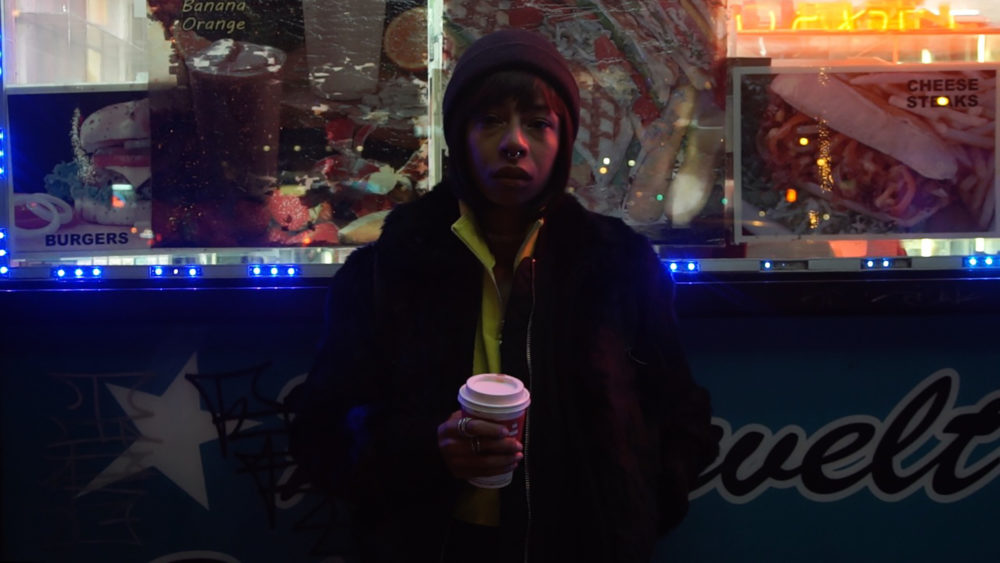For Day With(out) Art 2017, Visual AIDS commissioned seven new and innovative short videos from artists Mykki Blanco, Cheryl Dunye & Ellen Spiro, Tourmaline, Thomas Allen Harris, Kia LaBeija, Tiona Nekkia McClodden and Brontez Purnell. Curated by Erin Christovale and Vivian Crockett for Visual AIDS, the video program ALTERNATE ENDINGS, RADICAL BEGINNINGS prioritized Black narratives within the ongoing AIDS epidemic.
Below, Will Rawls responds to Kia LaBeija's video Goodnight, Kia. Read Kia LaBeija's artist statement here.

Bittersweet Kinetic
by Will Rawls
In the very last seconds of the short film “Goodnight, Kia,” Ms. LaBeija, approximately age nine, faces the camera in an undisclosed home movie scenario. Off-screen, a male voice says, “OK, and… ACTION.” After a momentary pause, LaBeija responds, “Which part?” This mysterious exchange comes even after the credits have rolled, a final question mark punctuating the moody, personal elegy that has preceded it. As the only dialogue in the film, it works like the winning coin slipped into a slot machine, causing the film to spill its riches, retroactively. We now spin backwards over the moving pictures, reviewing, inconclusively, which part, which gesture, which fragment best captures the subject occupying this work—and much of LaBeija’s artistic concern—her late mother Kwan Bennet. LaBeija intercuts archival home video of herself as an infant with outtakes of the home movie scenario and with recent, HD shots of her staring dreamily off into space. LaBeija lost her mother to complications from AIDS and was born HIV-positive. She continues to stage and reconfigure her body and work against these realities and against the over-determination that seropositivity can bring to an artistic signature. How and whether to separate life and art? As she says in the catalogue for ALTERNATE ENDINGS, RADICAL BEGINNINGS, “When I was younger I didn’t have the space to speak on my experiences. Now, I think I’ve said too much, that the parts of my story that are public have become who I am. I know I am so much more.” True to this statement, “Goodnight, Kia” deftly angles away from words, postponing them until the indeterminate inquiry that punctuates the film’s expansive visual reverie.
“Goodnight, Kia” comes across as a dance more than a scripted story, shuffling time, rhythm, action, space, image and disappearance, leaving subjective impressions across so many senses: An infant fed by a mother’s hand; A little girl restlessly waiting to say her lines; A photo of mother and child held against the sky; Dancing the Cabbage Patch; An empty hallway; A fleshy newborn cheek; A door closing; A camera crew snapping a clapperboard scrawled with the date: 11-3-99. It is a performance of memory and its mis en abyme through the technologies that fail to reconstruct it. Into the rapid shuffle of these shots LaBeija overlays the near-imperceptible flourish of backwards-running footage. People entering and leaving rooms, moving forward or back in time, cannot be distinguished as separate acts. LaBeija’s film subtly urges us to witness the tricks of time on our perception, of timing on our creation of meaning. It’s a deft, dancing study of association, apposition and time-as-material.
By mixing her brother’s home video footage with her own recent shots, LaBeija plays the temporal and textural differences of his 1990s videos against her hi-definition imagery from the 2010s. History embeds itself in the materiality of their images and into the bodies that appear. It is a time-traveling sibling effort. However the familial encounters remain temporally and technologically out of sync, choreographed into an imaginary sequence of visual echoes. This is a recursive, needy, unrestful memory at work reconstituting not only the childhood and mother that have passed, but also the luminous environment of her former apartment at 10th Avenue and 57th Street. In an inconclusive photoplay, the domestic and the documentarian interweave as modes of marking absence. There are as many shots that are missing a person as there are shots containing one. Our gaze is given the visual latitude to gingerly enter these near-empty rooms, peering over Kia’s shoulder while she cuts her life’s contours. The narrative spaciousness allows LaBeija’s filmmaking to be generous and self-probing, hyper-intimate and void-like. The affectations and truths of mourning dance at an inviting distance.
LaBeija is a phenomenal mover, known well for her familial ties to the vogue House of LaBeija. In her photographs, LaBeija echoes the work of Carrie Mae Weems, yet imbues her performance of urban domesticity with the colorful saturation of a vogue ball. One such project presents LaBeija in a glamorous dress against a New York City nightscape, fiercely posed, beat for the gods. In the words of Mx. Vivian Bond, glamour is resistance. Resistance, perhaps, to disappearance. “Goodnight, Kia,” however, temporarily lays the adornments of glamourous resistance down, revealing the unfinished weft of a commemorative address. She works here against the certainty of a still-life, exchanging it for the bittersweet kinetic raptures of filmic feeling. Set to the lush, looping tones of “Motherless Child” performed by her father Warren Benbow’s Spiritual Jazz Quartet, there is also something distinctly New York City about “Goodnight, Kia.” LaBeija conjures that romantic sense of solitude and survival that haunts so many New Yorkers. It’s a self-mythology reinforced by the generations of filmmakers that revere this sleepless city, a place hungry to swallow its subjects as they chase the selves of which they dream.
Will Rawls is a choreographer, performer and writer engaging with the instabilities of identity and form through live performance. Courting the ambiguous nature of dance as a medium, his choreographic practice employs movement, often in conjunction with text, objects and other media, to reconsider how personal and cultural histories are embodied, resisted and reconstructed.

